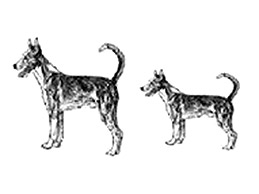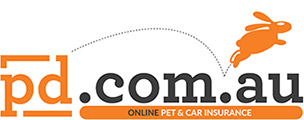Breed standards
Portuguese Podengo - Small Medium Large Smooth Haired - Small Medium Large Wire Haired
Breed standards are the official guidelines that describe the ideal characteristics, temperament, and appearance of a breed and ensures that the breed is fit for function with soundness essential.

Primitive type dog, it probably originates from the ancient dogs brought by the Phoenicians and Romans to the Iberian Peninsula in the Classic Antiquity. It was subsequently influenced by the introduction of dogs accompanying the Moors in their invasions in the 8th century. It adapted to the Portuguese terrain and climate, to become what is nowadays known as the Portuguese Warren Hound. It evolved morphologically throughout the centuries due to its functionality, with the small variety being selected, from the 15th century on, as a ratter on the Caravels of the Portuguese navigators.
Quadrangular pyramid head, with erect ears, sickle shaped tail, well proportioned, with sound construction and well muscled; very lively and intelligent; sober and rustic. It exists in three sizes, with two varieties of coat: smooth and wire.
Important proportions:
Large and Medium sized Podengo: Almost square (sub-mediolinear) of large or medium substance respectively. Ratio of length of body to height at the withers; 11/10 and depth of chest to height at withers:1/2.
Small Podengo: Body slightly longer than high (sub-longilinear), of small stature. The length of the body is slightly more than the height at withers with a ratio , length of body/ height at withers; 6/5 and depth of chest/height at withers 1/2. In all varieties, the muzzle is less than the skull length.
Large Podengo: used for hunting big game.
Medium Podengo: also known as Warren Hound, its natural aptitude as a rabbit hunter is well used, hunting either in a pack or alone.
Small Podengo: used for searching rabbits in holes and rocks.
All varieties are also used as watchdogs and as companion dogs.
Lean and of a quadrangular pyramid shape, with large base and definite pointed muzzle. The longitudinal superior cranium-facial axes are divergent.
Skull: Flat, almost straight in profile, prominent superciliary arches and scarcely perceptible frontal furrow. The area between the ears is horizontal with prominent occipital protuberance.
Stop: Barely defined.
Nose: Tapered and obliquely truncated, prominent at the tip. Of darker colour than the coat.
Muzzle: Pointed, curved seen from the front, with a straight profile. Shorter than the skull and broader at the base than at the tip.
Lips: Close fitting, thin, firm, horizontally cut and well pigmented.
Cheeks: Lean and obliquely set seen from the front.
Very lively expression, not prominent. They are small and slanted with the colouring ranging from honey to brown, in accordance with the coat. Lids darker than the coat colour.
Set on obliquely at the level of the eyes, straight, erect with high mobility. Vertical or tilting slightly forward, when attentive. Pointed, wider at the base, triangular, thin, of considerable length, more than the width at the base.
Normal with scissors bite, with solid, white teeth. Normal occlusion (relation of teeth) of both jaws. Full dentition in the large variety.
In a harmonious transition from head to body; straight, long, well proportioned, strong and well muscled, without dewlap.
Upright when seen from front and sides; well muscled and lean.
Shoulder: Long, inclined, strong and well muscled, scapula-humerus angle approximately 110 degrees.
Elbow: Parallel to the main line of the body.
Forearm: Vertical, long and well muscled.
Carpus (Pastern joint): Lean and not prominent.
Metacarpus (Pastern): Short, strong and slightly inclined.
Topline: Straight and level.
Withers: Only slightly visible in relation to the neck and back.
Back: Straight and long.
Loin: Straight, broad and well muscled.
Croup: Straight or slightly sloping, medium sized, broad and well muscled.
Chest: Down to the elbows, of moderate width, long, with the sternum rising back and up, ribs slightly sprung and inclined. Forechest neither too apparent nor too muscled and of moderate width.
Underline and belly: Slightly tucked up, lean belly and flanks.
Skin: Thin and tight. Mucous membranes preferably dark pigmented or always darker than the coat.
Upright when seen from back and sides; well muscled and lean, parallel to the main body.
Thigh: Long, of medium width, well muscled.
Stifle joint: Femur-tibia angle approximately 135 degrees
Second thigh: Inclined, long, lean, strong and well muscled.
Hock: Of medium height, lean, strong. Open hock angle approximately 135 degrees.
Metatarsus (Rear Pastern): Strong, short, inclined and without dewclaws.
Forefeet: Rounded, long toes, strong, tight and arched with strong and preferably dark nails, tough and firm pads.
Hindfeet: Rounded, long toes, strong, tight and arched, short and strong nails, preferably dark, tough and firm pads.
Natural, set on rather higher than low; strong, thick and thinning to tip, of medium length. At rest falls slightly curved between the buttocks down to the hocks. In action it rises horizontally either slightly curved or vertically in sickle shape, but never curled. Fringed on the under side.
Light trot. Easy and agile movement.
Two varieties. Either short and smooth or long and wire, both of medium thickness, without undercoat. The short coat is more dense than the wire coat. In the wire variety the hair on the muzzle is longer (bearded).
Yellow and fawn in all shades from light to dark, with or without white markings, or white with patches of these colours. In the small Podengo, the following colours are accepted but not preferred: black, brown, with or without white markings or white with patches of these colours.
Height:
Small 20-30 cm (8-12 ins)
Medium 40-54 cm (16-21 ins)
Large 55-70 cm (22-28 ins)
Weight:
Small 4-6 kg (9-13 lbs)
Medium 16-20 kg (35-44 lbs)
Large 20-30 kg (44-66 lbs)
Any departure from the foregoing points should be considered a fault and the seriousness with which the fault should be regarded should be in exact proportion to its degree and its effect on the health and welfare of the dog.
• Behaviour: Signs of shyness
• Cranium/Muzzle: Parallel longitudinal superior cranium (skull) to facial (muzzle) axes.
• Jaws: Incorrect occlusion or badly implanted teeth. Pincer bite. Incomplete dentition in the large variety.
• Nose: Partial lack of pigmentation.
• Neck: Arched.
• Body: Arched topline.
• Croup: Too sloping.
• Dewclaws: Their existence is not appreciated.
• Coat: Silky and/or with undercoat.
Severe Faults:
• Cranium/Muzzle: Convergent superior cranium (skull) to facial (muzzle) axes.
• Nose: Total lack of pigmentation.
• Ears: Rounded.
• Belly: Too tucked up
• Tail: Curled.
Disqualifying Faults:
• Behaviour: Aggressive or overly shy.
• General Appearance: Signs of cross breeding to sight hounds, pointing breeds or any other cross breeding.
• Jaws: Undershot or overshot.
• Eyes: Of different colours.
• Ears: Folded or hanging.
• Colour: Brindle, black and tan, tricolour and totally white.
Any dog clearly showing physical or behavioural abnormalities shall be disqualified.
N.B. Male animals should have two apparently normal testicles fully descended into the scrotum.



